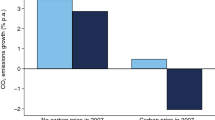Abstract
The European Union (EU) has set a target to reduce its greenhouse gas (GHG) emissions at least 10 % below the 2005 levels by 2020 in the non-Emission Trading Sector (non-ETS). As part of this, each Member State has a binding national emission limitation target for the non-ETS sector. Finland’s target, examined as a case study in this paper, is to reduce emissions at least 16 % below 2005 levels by 2020. The objective of this study is to find cost optimal mitigation portfolios that meet Finland’s reduction target and to analyze the risks of not attaining the emission target or exceeding the assumed costs. The question was addressed with a stochastic optimization model, Stochastic Optimization of non-ETS Emissions (SONETS) selecting separate mitigation measures that meet the target on expectation. The results show that optimal portfolios include relatively high uncertainty both in costs and achieved reductions. The prices of crude oil and diesel, and the abatement cost of reducing hydrofluorocarbon (HFC) emissions seem to account for the majority of uncertainty regarding total costs. The baseline predictions for various non-ETS subsectors (such as transport and agriculture) were found to have the greatest contribution to the uncertainty of attaining emission target. The results also show that some abatement actions are chosen in nearly all efficient portfolios, while other actions are seldom chosen. For example replacing oil burners in the end of technical life time or recovery of methane (CH4) from waste are often chosen whereas ban of landfilling of organic waste is chosen extremely seldom. It also seems that the results are somewhat sensitive to the inclusion or exclusion of the interdependencies of mitigation measures.










Similar content being viewed by others
References
Ayyub B (2001) Elicitation of expert opinions for uncertainty and risks. CRC Press. p 328.
Hast A (2011) Assessment of risks and cost-efficiency of the Finnish national emission reduction measures (in Finnish). Aalto University, Master’s Thesis
Hast A, Ekholm T, Savolainen I (2011) Assessment of uncertainties and risks of national greenhouse gas abatement actions in Finland (in Finnish). VTT Working Papers 165. p 47.
Manne AS, Richels RG (1991) Buying greenhouse insurance. Energ Pol 19(6):543–552
Monni S, Peltoniemi M, Lehtonen A, Mäkipää R, Savolainen I (2007) Uncertainty of forest carbon stock changes—implications to the total uncertainty of GHG inventory of Finland. Clim Chang 81:391–413
Nordhaus WD (1991) To slow or not to slow: the economics of the greenhouse effect. Econ J 101(407):920–937
Plevin R (2010) Life cycle regulation of transportation fuels: uncertainty and its policy implications. Doctoral dissertation. University of California, Berkeley. http://plevin.berkeley.edu/docs/Plevin-Dissertation-2010.pdf
Rypdal K, Winiwarter W (2001) Uncertainties in greenhouse gas emission inventories—evaluation, comparability and implications. Environ Sci Pol 4:107–116
Soimakallio S, Mäkinen T, Ekholm T, Pahkala K, Mikkola H, Paappanen T (2009) Greenhouse gas balances of transportation biofuels, electricity and heat generation in Finland—dealing with uncertainties. Energ Pol 37:80–90
Statistics Finland (2011) Official Statistics of Finland (OSF): Greenhouse gases [e-publication]. ISSN = 1797-6065. 2009. Helsinki: Statistics Finland [referred: 29.6.2011]. Access method: http://www.stat.fi/til/khki/2009/khki_2009_2011-04-28_tie_001_en.html.
Syri S, Lehtilä A, Ekholm T, Savolainen I, Holttinen H, Peltola E (2008) Global energy and emissions scenarios for effective climate change mitigation—deterministic and stochastic scenarios with the TIAM model. Int J Greenh Gas Control 2:274–285
Winiwarter W, Rypdal K (2001) Assessing the uncertainty associated with national greenhouse gas emission inventories: a case study for Austria. Atmos Environ 35:5425–5440
Author information
Authors and Affiliations
Corresponding author
Appendices
Appendices
Expected values of GHG reduction [Mt CO2-eq] achieved cumulatively per abatement action over the 2010–2020 timeline according to the year of implementation. Even if each action can be implemented in any year from 2010 to 2020, the implementation years of 2010, 2015 and 2020 are examined in this figure only
Expected values of total costs [M€] per abatement action according to the year of implementation. The amount of costs depends on the timing of implementation and the costs correspond to the implementation years of 2010, 2015 and 2020. However it should be noted that measures can be implemented in any year from 2010 to 2020 in the optimization model. Since many measures cause costs in several years after implementation, the sum of costs (as 2010 present values) from years 2010–2020 are represented in this figure
Rights and permissions
About this article
Cite this article
Hast, A., Ekholm, T. & Savolainen, I. Meeting emission targets under uncertainty—the case of Finnish non-emission-trading sector. Mitig Adapt Strateg Glob Change 18, 637–658 (2013). https://doi.org/10.1007/s11027-012-9379-1
Received:
Accepted:
Published:
Issue Date:
DOI: https://doi.org/10.1007/s11027-012-9379-1






